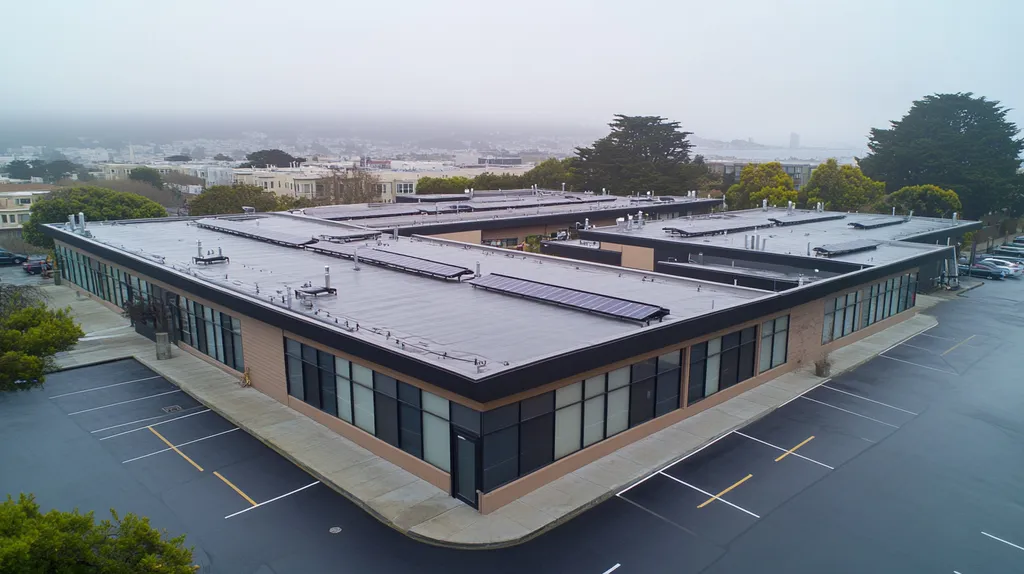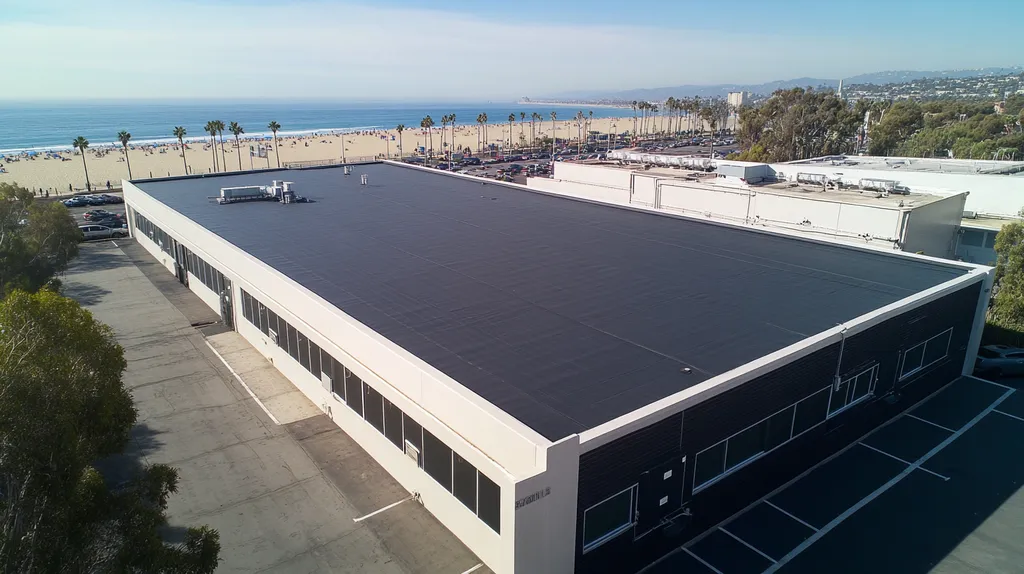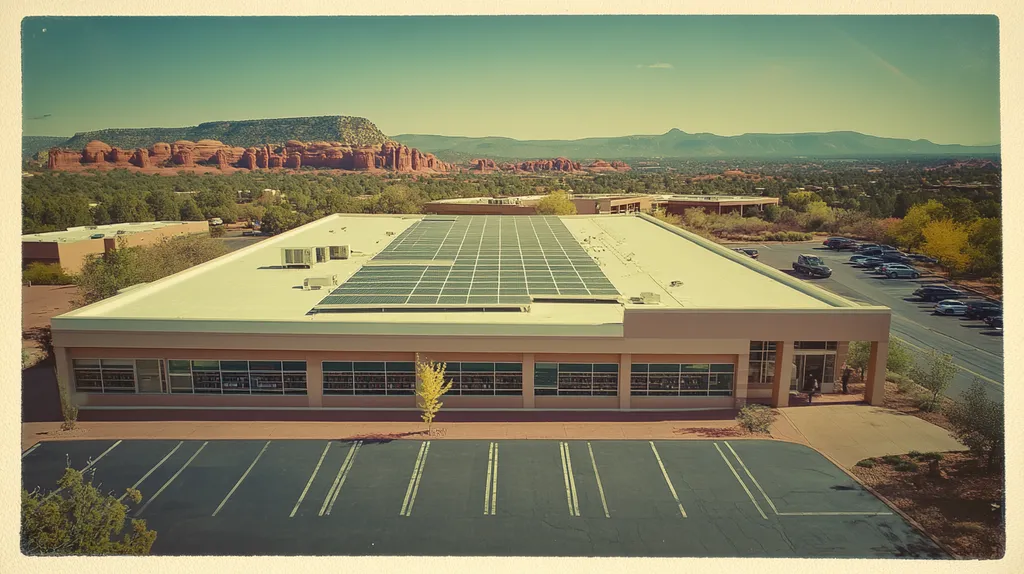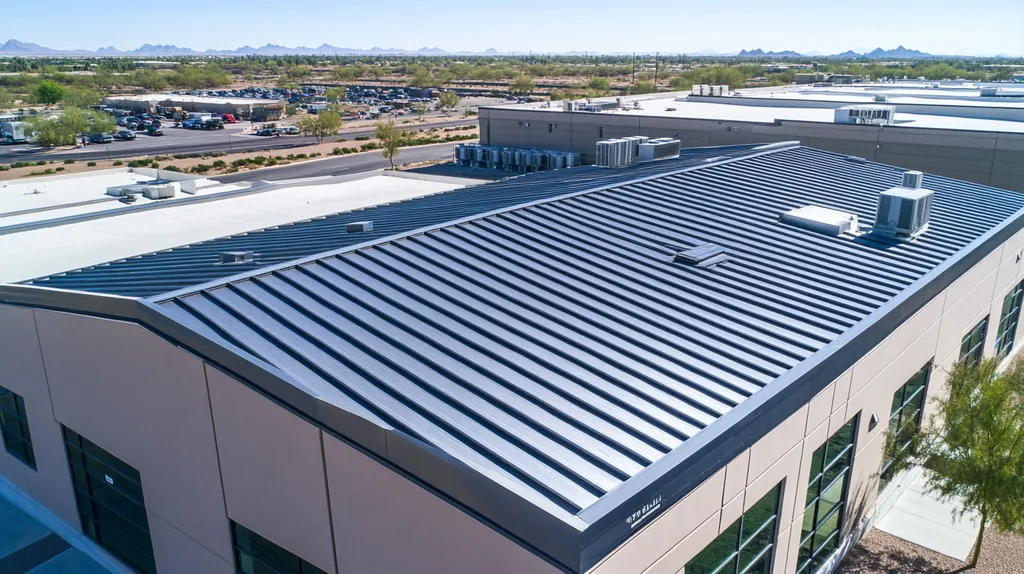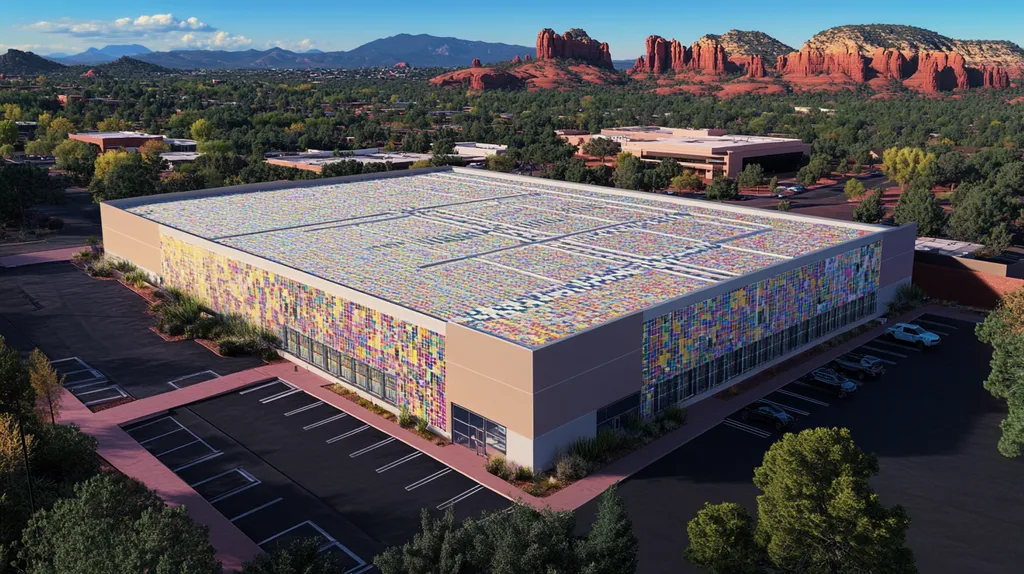In industrial roofing, the difference between safety and catastrophe often comes down to a single sign. With falls accounting for 33% of construction-related fatalities annually, proper safety signage isn’t just about compliance—it’s about saving lives.
From warning markers to directional indicators, a comprehensive signage system forms the backbone of any effective roofing safety protocol.
This guide breaks down the essential elements of industrial roofing signage, exploring everything from basic terminology to practical implementation strategies that keep workers safe and projects on track.
SECTION 1: THE BASICS EXPLAINED
In the world of industrial roofing, safety is not just a suggestion—it’s a necessity. With falls accounting for a staggering number of workplace injuries and fatalities, effective safety signage emerges as a vital line of defense. Did you know that over 200 construction workers lose their lives each year due to preventable falls? This stark reality underscores the importance of understanding and implementing safety signage on roofing sites, protecting both workers and compliance standards.
What It Is (In Plain Language)
Safety signage plays a pivotal role in keeping industrial roofing sites safe. These signs deliver essential information about hazards and safe practices, covering everything from warning signs to barricades and directional markers. Each type is designed to serve a specific function, helping workers identify dangers like slippery surfaces or guiding them toward safe exits.
It’s crucial for signage to be clear and easily understood at a glance. Utilizing color-coded systems enhances recognition—for example, red flags danger while yellow signals caution. This visual shorthand enables workers to spot and respond to risks without hesitation.
Moreover, safety signs often communicate necessary guidelines for personal protective equipment (PPE) requirements. By reinforcing the importance of wearing appropriate gear, these signs contribute to building a culture of safety and compliance among workers.
In summary, effective safety signage isn’t merely a box to check for compliance; it’s a foundational element of a comprehensive safety approach for industrial roofing sites.
Why It Matters (To Your Building)
Having proper signage in place is essential for cultivating a safe work environment and preserving the integrity of the roofing system itself. When employees are informed of potential hazards, they can take preemptive measures to prevent accidents, positively impacting the building’s safety track record.
Additionally, a clearly signed site can significantly cut down on downtime resulting from workplace incidents. An injury or accident can halt work for an extended period, negatively affecting productivity and escalating expenses. A commitment to safety, backed by visible signage, helps keep projects on track and within budget.
Furthermore, the facility’s safety record directly influences insurance premiums. Significant accidents could drive rates up, squeezing the operational budget. By investing in effective signage, companies can signal their commitment to safety, potentially resulting in lower insurance costs.
Ultimately, the implications of safety signage reach far beyond compliance; they shape operational efficiency and influence the bottom line.
How It Works
Safety signage thrives on the principle of clear communication, alerting workers to potential hazards on the roofing site. By distilling complicated safety messages into straightforward visuals, companies create an environment where safety takes center stage.
For maximum effectiveness, signs should be placed thoughtfully in high-traffic areas or zones where hazards are prevalent. For instance, positioning warning signs near edge boundaries can drastically reduce fall-related accidents. Visibility can be enhanced with reflective materials or lighting, ensuring that signs are noticeable at all times.
The impact of signage is amplified through training and awareness programs. Equipping employees with knowledge about what each sign means empowers them to act responsibly and safely. Regularly reviewing and updating signage helps maintain compliance and reinforces its relevance.
In essence, effective safety signage is more than just a passive component of a safety plan; it’s an active participant in the broader risk management strategy on industrial roofing sites.
SECTION 2: PRACTICAL APPLICATIONS
In the fast-paced world of industrial roofing, safety signage is not just an accessory; it’s an essential tool for protecting workers. With falls being a leading cause of injuries in construction, effective signage acts as a vital alert system, warning workers about potential hazards and reducing the likelihood of accidents. By deploying smart signage strategies, property owners enhance safety while remaining compliant with industry regulations. This section explores the common applications of signage, critical situations where they are most needed, and how they interact with other safety measures on site.
Common Uses & Examples
Signage on industrial roofing sites fulfills several vital roles. Warning signs effectively indicate perilous conditions, such as steep edges or unstable surfaces, ensuring workers navigate these hazards safely. Instructional signs detail the necessary personal protective equipment (PPE), like harnesses and hard hats, emphasizing adherence to safety regulations.
Directional signs guide workers to key locations, such as emergency exits or first aid stations, enabling quick access during critical moments. The effectiveness of signage hinges on clear visibility, durability against the elements, and straightforward messaging. For instance, placing “Caution: Roof Work Ahead” signs at entrances alerts both workers and visitors to the potential dangers ahead.
Using bright colors like neon for warning signs ensures they stand out in adverse weather, grabbing attention when it counts most. Each sign plays a part in weaving a comprehensive safety net that protects everyone on site.
When You Need It Most
Strategically positioned signage is crucial during critical phases of roofing projects, especially during installation and maintenance. These periods present heightened hazards, such as open edges and operating machinery. Establishing signage before work begins is essential to prevent accidents.
For example, during new roof installations, clearly marked signs can indicate zones where heavy materials are being lifted, helping prevent personnel from inadvertently entering these dangerous areas. Signage remains equally important during maintenance when distractions can lead to lapses in safety. Constant reminders help keep safety protocols top of mind.
Additionally, signage in scaffolding areas and near equipment is critical. Warning signs can deter unauthorized personnel from accessing dangerous zones, reinforcing respect for safety boundaries and protecting everyone involved.
Interactions With Other Systems
Signage is integral to a holistic approach to site safety, complementing other safety systems in place. For instance, fall protection measures should work in tandem with clear warning signage. Signs stating “Fall Hazard – Use Harness” serve as frequent reminders for workers to prioritize their safety equipment.
This synergy enhances compliance and focuses workers’ attention on their responsibilities. Emergency response plans should incorporate signage indicating evacuation paths and assembly points. Consistently displaying these signs helps ensure that everyone understands the actions to take during emergencies.
Moreover, integrating signage into safety training programs amplifies their importance. Training sessions should cover the meaning of these signs, empowering workers to interpret and respond correctly to them. By merging signage with broader safety measures, companies foster a robust safety culture on industrial roofing sites—maximizing accident prevention and promoting a secure working environment for all.
SECTION 3: KEY TERMINOLOGY DECODED
In the complex world of industrial roofing, understanding the lingo can be a game-changer. Misinterpreting crucial terms can lead to unsafe practices and costly liabilities. Did you know improper signage alone can raise accident rates by a staggering 30%? This section unwraps the essential terminology, translates industry jargon, and simplifies measurements, empowering property owners and facility managers to make informed and safe decisions on roofing sites.
Essential Terms Explained
A solid grasp of key safety terms is essential for effective communication on any industrial roofing site. Take “fall protection,” for example—it refers to systems or equipment that act as safety nets for workers, including harnesses, guardrails, and safety nets.
Next up is “exposure limits,” which denote the maximum amount of hazardous substances, like harmful chemicals, that workers can safely encounter. Being aware of these limits is vital for keeping everyone safe and sound on the job.
Let’s not forget “signage.” This term covers all types of safety signs, including warning, instructional, and prohibition signs. Each sign serves an important function in alerting workers to potential hazards that they should be aware of.
Lastly, understanding terms like “OSHA compliance” is crucial for ensuring that all safety measures align with federal standards. Familiarity with this vocabulary empowers property owners and facility managers to actively promote a safer workplace.
Industry Jargon Translated
The industrial roofing landscape is rife with specialized terms that can confuse even the most seasoned professionals. For instance, “load-bearing capacity” describes the maximum weight a roofing structure can withstand without risking structural integrity. Misunderstanding this concept could lead to dangerous overload situations.
Another term you’ll encounter is “drainage slope,” which indicates the angle of the roof designed for optimal water runoff. If the slope is insufficient, ponding can occur, increasing the risk of leaks and structural degradation.
Additionally, you’ll come across phrases like “thermal expansion,” which describes how roofing materials change size with temperature fluctuations. Awareness of this phenomenon helps prevent material damage and ensures the roof remains intact for years to come.
Measurement & Units Simplified
Accurate measurement is fundamental to the success of any roofing project. Roof area is typically measured in square feet, so being able to measure accurately ensures that the right amount of materials are ordered without waste.
Pitch is another important concept—it indicates how steep the roof is, expressed as a ratio, like 4:12. This means a rise of four inches for every twelve inches of run. Understanding pitch helps in proper design and drainage.
Then there’s “gauge,” especially relevant for materials like metal roofing, measuring thickness. A lower gauge number signifies thicker material, which directly influences both durability and cost.
Lastly, metrics such as “R-value” measure the effectiveness of insulation in roofing materials. A higher R-value indicates better thermal resistance, which can play a significant role in reducing heating and cooling expenses for the building.
SECTION 4: DECISION FACTORS
In the high-stakes environment of industrial roofing, choosing the right signage isn’t just about making a site look professional; it’s a critical element of keeping workers safe. With falls accounting for nearly 40% of construction-related fatalities, investing in effective signage can be a lifesaver—literally. Property owners and facility managers must evaluate several key factors when selecting signage that meets safety and compliance standards. This section delves into the essential decision factors: cost considerations, performance trade-offs, and lifespan and durability factors.
Cost Considerations
While the initial price of signage may seem appealingly low, hidden costs can quickly stack up. Choosing cheaper materials might save money upfront but often leads to frequent replacements, ultimately driving up long-term expenses. Conversely, investing in high-quality signage ensures clarity and visibility, both vital for safety compliance and accident prevention.
Moreover, effective signage helps avert liability issues by reducing the risk of accidents. When safety measures fail, property owners could face expensive lawsuits that impact their bottom line. Thus, viewing quality signage as an investment in safety and financial health is essential.
It’s common for companies to focus solely on upfront costs while disregarding ongoing maintenance and durability. Selecting signage that meets established industry standards often pays off in the long run, especially in hazardous environments where a single sign can vastly influence safety outcomes.
Ultimately, decision-makers should calculate the total cost of ownership—not simply the purchase price—ensuring that signage contributes meaningfully to workplace safety.
Performance Trade-offs
Performance is king when it comes to signage. Signs must not only convey information clearly but also endure various environmental conditions. In harsh weather, signage materials need to resist fading and damage to maintain effectiveness.
Some lower-cost materials might falter under extreme conditions, so facility managers must balance cost against longevity to avoid frequent sign replacements. Signs that deteriorate can confuse workers and lead to increased hazards on the site.
Additionally, the design of signage plays a crucial role in its effectiveness. Clear, concise messages help minimize misunderstandings that could potentially result in accidents. Using visuals and high-contrast colors boosts visibility, particularly in low-light situations common on roofing sites.
The ultimate goal is to enhance safety while meeting performance expectations. Recognizing the value of investing in high-performance signage can significantly reduce liability and ensure adherence to safety regulations.
Lifespan & Durability Factors
The lifespan and durability of signage are vital for maintaining long-term safety on industrial roofing sites. Signs made from high-quality materials can withstand harsh conditions and last for years, reducing replacement costs and ensuring continuous safety communication.
Exposure to elements like UV rays, moisture, and extreme temperatures can degrade signage quickly. Therefore, selecting weather-resistant materials is crucial. Signs that struggle to endure may lead to miscommunication, jeopardizing worker safety in the process.
Moreover, signs should adhere to industry standards for durability. Compliance with ASTM ratings and local regulations is essential for building trust in the signage selected. Companies that prioritize compliant, durable signage demonstrate a strong commitment to safety.
In summary, when evaluating longevity and durability, facility managers must prioritize quality. Durable signage not only enhances safety but also ensures a secure working environment throughout its entire lifespan.
SECTION 5: COMMON CHALLENGES
On industrial roofing sites, safety isn’t just a checkbox; it’s critical for saving lives. With falls leading to 33% of construction-related fatalities, according to OSHA, safety signage is a frontline defense. Common challenges include insufficient signage, overlooked warnings, and ambiguous instructions, all of which can elevate risk. By tackling these issues head-on, the goal is to significantly reduce accidents and bolster the safety of roofing operations.
Frequent Problems & Solutions
A frequent pitfall on industrial roofs is the lack of adequate warning signs, leaving workers in the dark about potential hazards. To combat this, property owners should invest in clear, eye-catching signage that effectively communicates the nature and level of risks.
Another dilemma arises from poorly placed signs; if they’re blocked or misplaced, their visibility and impact diminish. Facilities managers should regularly inspect signage to ensure it’s always visible and properly positioned.
Complex language on signs can also confuse workers. Simple wording and universally understood symbols are key to enhancing clarity and reducing accident risks.
Additionally, providing comprehensive training about signage for employees can significantly boost understanding. When workers know what various signs mean, they’re more likely to follow safety protocols, fostering a safer work environment.
Warning Signs To Watch For
Being mindful of warning signs is essential for preventing accidents. A major red flag is the frequency of near-miss occurrences, indicating that workers may not be well-informed about potential dangers. Monitoring these incidents can offer valuable insight into signage effectiveness.
If employees often show hesitation or confusion regarding safety protocols, this may suggest that the signage is inadequate. Regular check-ins to assess workers’ understanding can guide necessary improvements in safety communication.
Moreover, obstructions in pathways or work areas can signal poor sign placement. Site inspections should prioritize ensuring that signs are easily visible and not hidden by equipment or materials.
Finally, any uptick in accident reports or safety violations might hint at ineffective warning systems. Tracking these trends can help managers pinpoint where signage and procedures may need reinforcement.
Preventative Approaches
Proactive strategies can dramatically enhance safety outcomes on roofing projects. Developing a comprehensive signage management plan should top the priority list for facility managers. This plan involves regularly reviewing existing signs to ensure compliance with the latest safety regulations and standards.
Conducting safety audits is another effective way to pinpoint gaps in communication. Such audits can reveal which signs lack clarity and which hazards need better representation.
Incorporating technology can also elevate safety protocols. For instance, real-time hazard identification through digital displays can serve as a powerful supplement to traditional signage, providing immediate updates on roofing operations.
Lastly, nurturing a safety-first culture among the workforce is paramount. Engaging employees in safety discussions and encouraging them to voice concerns can lead to a more alert and responsive environment where signage effectiveness is continually monitored.
SECTION 6: NEXT STEPS & RESOURCES
When it comes to keeping workers safe on industrial roofing sites, the right safety signage isn’t just a nice-to-have—it’s a must-have. Inadequate signage can lead to severe accidents, with OSHA reporting that ineffective hazard communication contributes to injuries every year. Property owners and facility managers must take proactive measures to ensure that safety signage is both effective and compliant. This section details essential questions to ask roofing providers, the key industry standards to follow, and resources for continued learning.
Questions To Ask Providers
Asking the right questions when engaging with roofing providers can make all the difference in safety. Start with their experience—how familiar are they with safety signage on industrial roofs? Understanding their background can reveal valuable insights into their capability to assess unique roof environments.
Next, ask how they tailor signage solutions to meet the specific conditions of your site. Generic signage might not address unique hazards, while customized options can significantly improve clarity and effectiveness. It’s also vital to confirm their knowledge of regulatory requirements that guide safety signage standards.
Inquire about the materials used for signage durability. Signs exposed to the elements should be made from high-quality, weather-resistant materials that resist fading and damage, ensuring they remain visible. Lastly, check if they provide installation services to properly position signs where they’ll have the greatest impact on safety.
Industry Standards & Guidelines
Keeping up with industry standards is essential for fostering a safe roofing environment. OSHA and the National Institute for Occupational Safety and Health (NIOSH) offer specific guidelines for safety signage in industrial settings that underline the importance of clear hazard communication.
Signage should utilize universally recognized symbols and colors to convey safety messages effectively. For instance, red typically represents danger, while yellow indicates caution. By complying with these standards, companies not only improve worker safety but also reduce legal risks.
Regularly reviewing and updating your signage according to these guidelines is crucial for maintaining a consistent and compliant safety culture. This commitment not only protects workers but also boosts employee morale, fostering a productive workplace.
Further Learning Simplified
Staying informed about best practices in safety signage can provide significant benefits for property owners and managers. Numerous online resources and webinars are available, offering insights into the latest trends and evolving regulations in industrial safety. Websites like the National Safety Council (NSC) and OSHA are treasure troves of accessible materials that break down complex guidelines into actionable steps.
Engagement in industry associations can also be highly beneficial. Networking with peers often yields new ideas and solutions for safety signage that can be tailored to specific facilities. Additionally, local safety workshops frequently offer hands-on training to enhance understanding of effective signage.
Finally, attending trade shows and industry conferences is an excellent way to discover innovative signage solutions and technologies that may elevate workplace safety. Continuous learning is a shared responsibility that can lead to a noticeable decline in hazards on roofing sites.
The Bottom Line
With workplace falls claiming over 300 lives annually, effective safety signage isn’t optional—it’s imperative for every industrial roofing site.
Clear, properly maintained signage can reduce accident rates by up to 50% and slash liability costs significantly.
From essential warning markers to comprehensive directional systems, safety signage forms the foundation of accident prevention and regulatory compliance.
By implementing durable, visible, and regulation-compliant signage, facility managers protect both their workers and their bottom line.
The investment in quality safety signage pays dividends through reduced accidents, improved worker confidence, and enhanced operational efficiency.
The message is clear: when it comes to rooftop safety, proper signage isn’t just about following rules—it’s about saving lives.
FREQUENTLY ASKED QUESTIONS
Q. What is the role of safety signage on a commercial roof?
A. Safety signage is crucial for communicating hazards and safe practices on roofing sites. It helps workers recognize potential dangers and comply with safety regulations. Clear signs indicate risks and necessary protective measures, ultimately fostering a safer work environment.
Q. How can signage prevent accidents on an industrial roof?
A. Well-placed signage alerts workers to hazards and required safety gear during risky tasks. By clearly marking danger zones and safe pathways, risk is minimized, reducing incident rates. The visibility of these signs keeps safety at the forefront of every worker’s mind.
Q. What common signage types should be used on industrial roofs?
A. Crucial signage types include warning signs for hazards, instructional signs for PPE use, and directional signs for emergency exits. Together, they create a clear communication system that ensures workers are informed and safe while navigating the site.
Q. How do I know if my signage is effective during industrial roofing projects?
A. Assess signage effectiveness by monitoring near-miss incidents and worker feedback. If signs are frequently ignored or misunderstood, consider revising them for clarity and visibility. Regular inspections also ensure that signs remain unobstructed and easily interpretable.
Q. What factors impact signage cost for commercial roofs?
A. Key factors influencing cost include material quality, sign size, and customization options. Cheaper materials might save initial costs but lead to higher long-term expenses due to replacements. Quality signage ensures durability and clarity, crucial for effective hazard communication.
Q. How should signs be placed on an industrial roof for maximum visibility?
A. Position signs in high-traffic areas and near major hazards, ensuring they’re unobstructed. Use bright colors and reflective materials for enhanced visibility, especially during low-light conditions. Regular inspections can help maintain their prominent placement, promoting ongoing safety awareness.
Q. What are best practices for maintaining safety signage on commercial roofs?
A. Regularly inspect signs for visibility and condition, replacing any that are faded or damaged. Update signage to reflect new hazards or changes in procedures. Provide ongoing training to workers on the meaning of signs, ensuring they remain aware and compliant.

